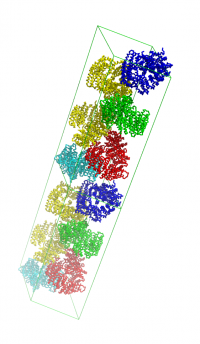Supercell
Jump to navigation
Jump to search
The printable version is no longer supported and may have rendering errors. Please update your browser bookmarks and please use the default browser print function instead.
supercell can display multiple copies of the unit cell. Can also fill the unit cell (and its copies) with symmetry mates.
See thread on pymol-users mailing list.
Requires numpy.
Example
run supercell.py
fetch 2x19, async=0
supercell 2,1,1, 2x19, green
supercell 1,1,2, 2x19, orange, name=super2
The Code
'''
(c) 2010 Thomas Holder
PyMOL python script (load with `run supercell.py`)
Usage: See "help supercell" and "help symexpcell"
'''
from pymol import cmd, cgo, xray
from math import cos, sin, radians, sqrt
import numpy
def cellbasis(angles, edges):
'''
For the unit cell with given angles and edge lengths calculate the basis
transformation (vectors) as a 4x4 numpy.array
'''
rad = [radians(i) for i in angles]
basis = numpy.identity(4)
basis[0][1] = cos(rad[2])
basis[1][1] = sin(rad[2])
basis[0][2] = cos(rad[1])
basis[1][2] = (cos(rad[0]) - basis[0][1]*basis[0][2])/basis[1][1]
basis[2][2] = sqrt(1 - basis[0][2]**2 - basis[1][2]**2)
edges.append(1.0)
return basis * edges # numpy.array multiplication!
def supercell(a=1, b=1, c=1, object=None, color='blue', name='supercell', withmates=1):
'''
DESCRIPTION
Draw a supercell, as requested by Nicolas Bock on the pymol-users
mailing list (Subject: [PyMOL] feature request: supercell construction
Date: 04/12/2010 10:12:17 PM (Mon, 12 Apr 2010 14:12:17 -0600))
USAGE
supercell a, b, c [, object [, color [, name [, withmates]]]]
ARGUMENTS
a, b, c = integer: repeat cell in x,y,z direction a,b,c times
{default: 1,1,1}
object = string: name of object to take cell definition from
color = string: color of cell {default: blue}
name = string: name of the cgo object to create {default: supercell}
withmates = bool: also create symmetry mates in displayed cells
{default: 1}
SEE ALSO
show cell
'''
if object is None:
object = cmd.get_object_list()[0]
withmates = int(withmates)
sym = cmd.get_symmetry(object)
cell_edges = sym[0:3]
cell_angles = sym[3:6]
basis = cellbasis(cell_angles, cell_edges)
assert isinstance(basis, numpy.ndarray)
ts = list()
for i in range(int(a)):
for j in range(int(b)):
for k in range(int(c)):
ts.append([i,j,k])
obj = [
cgo.BEGIN,
cgo.LINES,
cgo.COLOR,
]
obj.extend(cmd.get_color_tuple(color))
for t in ts:
shift = basis[0:3,0:3] * t
shift = shift[:,0] + shift[:,1] + shift[:,2]
for i in range(3):
vi = basis[0:3,i]
vj = [
numpy.array([0.,0.,0.]),
basis[0:3,(i+1)%3],
basis[0:3,(i+2)%3],
basis[0:3,(i+1)%3] + basis[0:3,(i+2)%3]
]
for j in range(4):
obj.append(cgo.VERTEX)
obj.extend((shift + vj[j]).tolist())
obj.append(cgo.VERTEX)
obj.extend((shift + vj[j] + vi).tolist())
if withmates:
symexpcell('m%d%d%d_' % tuple(t), object, *t)
obj.append(cgo.END)
cmd.delete(name)
cmd.load_cgo(obj, name)
def symexpcell(prefix='mate', object=None, a=0, b=0, c=0):
'''
DESCRIPTION
Creates all symmetry-related objects for the specified object that
occur with their bounding box center within the unit cell.
USAGE
symexpcell prefix, object, [a, b, c]
ARGUMENTS
prefix = string: prefix of new objects
object = string: object for which to create symmetry mates
a, b, c = integer: create neighboring cell {default: 0,0,0}
SEE ALSO
symexp, http://www.pymolwiki.org/index.php/SuperSym
'''
if object is None:
object = cmd.get_object_list()[0]
sym = cmd.get_symmetry(object)
cell_edges = sym[0:3]
cell_angles = sym[3:6]
spacegroup = sym[6]
basis = cellbasis(cell_angles, cell_edges)
basis = numpy.matrix(basis)
extent = cmd.get_extent(object)
center = sum(numpy.array(extent)) * 0.5
center = numpy.matrix(center.tolist() + [1.0]).T
center_cell = basis.I * center
extra_shift = [[float(i)] for i in (a,b,c)]
i = 0
matrices = xray.sg_sym_to_mat_list(spacegroup)
for mat in matrices:
i += 1
mat = numpy.matrix(mat)
shift = numpy.floor(mat * center_cell)
mat[0:3,3] -= shift[0:3,0]
mat[0:3,3] += extra_shift
mat = basis * mat * basis.I
mat_list = list(mat.flat)
name = '%s%d' % (prefix, i)
cmd.create(name, object)
cmd.transform_object(name, mat_list)
cmd.color(i+1, name)
cmd.extend('symexpcell', symexpcell)
cmd.extend('supercell', supercell)
# tab-completion of arguments
cmd.auto_arg[3]['supercell'] = [ cmd.object_sc, 'object', '']
